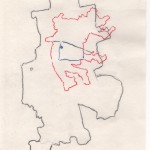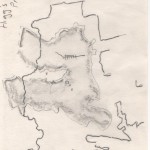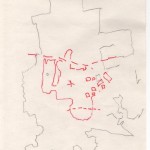This early-January launch was inserted in the schedule to provide an opportunity for several NASA Student Launch Initiative (SLI) teams to gain some experience with their sub-scale models and with practical rocketry in general.? Quite a few other Tripoli members showed up to enjoy the fantastic weather (on Saturday) and we ended up with good attendance (for a January, that is).? The weather was the big story, as it so often is in the middle of winter, and the short version is that, yes, we did have some weather!? Saturday was just fantastic, calm winds, clear blue skies, and temperatures in the 40s warming up to the low 50s.? It had rained all week in Bayboro, so the mud was everywhere, making vehicular traffic a bit chancy anywhere but the pavement.? Sunday was a wholly different situation:? Cold, very windy, especially above about 1000 feet above the ground, and rain all day long that varied from a clammy mist to steady rain.
Let?s have a motor use summary and then I?ll fill in some details.
| Motor | Sat | Sun | Total |
| C | 4 | 4 | |
| D | 1 | 1 | |
| E | |||
| F | 2 | 2 | |
| G | 4 | 4 | |
| H | 1 | 1 | |
| I | 3 | 3 | 6 |
| J | 2 | 1 | 3 |
| K | 2 | 2 | |
| L | 2 | 2 | |
| M | 3 | 3 | |
| N | 1 | 1 | |
| All | 25 | 4 | 29 |
Not a huge weekend by any standards, but for a one-off event in January, held on short notice, it was a pretty good turnout.? Ed Withers and Vivienne English kept the low-power pads busy, and Andrew Billin and Warren English kept the commercial motor flights coming all day long, lots of attempts in the C through K range.
Johnny Hoffman and Sam Chesnutt came from South Carolina to pass some serious gas in the wide open spaces of Bayboro, and both had very impressive flights of M-sized hybrid motors.? Both motors seemed to burn for almost 9 seconds and got way, WAY up there.? Sam recovered his over by the new red and white tower, while Johnny?s was not seen again, there was no signal from the Walston tracker, for the rest of the day and on into Sunday.? Be on the lookout for that one.
Ray Bryant is making big advances in sugar propellant reliability, and on Saturday he had 3 completely successful flights, with KNO3/sorbitol motors in the I, J, and big K/small L range.
Other flyers of homemade motors included Jim Livingston, who flew the Carbon Hi on a 4-grain 115mm N motor made from a very nice White Lightning clone up to 11,895 feet, passing through Mach 1 on the way (1185 feet/sec maximum recorded velocity).? Alan Whitmore later flew the Red Rudy out to the same speed range, but this time the monster got his pound of flesh:? the fins ripped off at Mach 0.97 and the body turned sideways, deploying the main chute and filling the sky with thousands of shiny bits of painted body tube.? A quote from the late Ed Rowe seems appropriate:? ?Oh well, I guess I?ll just have to build another rocket.?
The lone SLI team putting in an appearance on Saturday didn?t arrive until much too late, ran into construction problems, and could not get the rocket into the air before dark.
I have already described the weather on Sunday so I won?t dwell on it, other than to say that my wife got me a new pair of winter boots for Christmas, and by the time I finally pulled the trailer off the field at 4:30, the only part of me that wasn?t cold and wet and numb was my feet!?? I want to recognize Jen and Tim Christiansen with a huge thank you for the hot chocolate and warm biscuits they brought us from Bojangles after watching the NCSSM flight.
Two SLI teams had success on Sunday.? The team from the North Carolina School of Science and Math launched their Dart subscale model on a I161W for a fantastic flight, and the North Carolina State University team gathered a huge amount of data on ejection charges before attempting their flight of the Failed Soviet Project on a J401FJ, which shed a fin somewhere during the flight, but which deployed all the events right on time.? You would need to see the paint job on this little ?beauty? to make sense of their name for this rocket, which also wins my favorite rocket name of the weekend contest.
Alan Whitmore flew his Astro*Mollusk VII on a 6-grain 38mm motor to 2865 feet, and Dave Morey came back with his Onyx to attempt another air-start cluster with a central H210R, 3 E9s and 3 D5s lighting a second or so later.? This time the E9s were very well ?behaved and the flight and recovery were perfect.
I?ll see you at the NC Museum of Natural Science for Astronomy Days, or at the field at Bayboro, or maybe both, on the weekend of January 26 and 27.
Alan Whitmore, Prefect, Tripoli East NC
p.s.? I am going to send Tanner three tracings I made while messing about on Google Earth over the holidays.? I wanted some images of how much larger the Bayboro site is than several of the other places we are all familiar with.? I traced the edge of the clear area (no trees) at Bayboro, and then I went to the maps for Whitakers, Orangeburg, and Price, Maryland and adjusted the view to the same scale, and traced the open, treeless areas there.? On the image for ?Whitakers?, the entire cow pasture that constituted our primary launch area, is outlined in blue ink in the center.? The images speak for themselves.




